With the help of citizen scientists, astronomers discovered what may be the last three planets that the Kepler Space Telescope saw before it was retired. This illustration depicts NASA’s Kepler Space Telescope, which retired in October 2018, and three planets discovered in its final days of data. Image Credit: NASA’s Jet Propulsion Laboratory
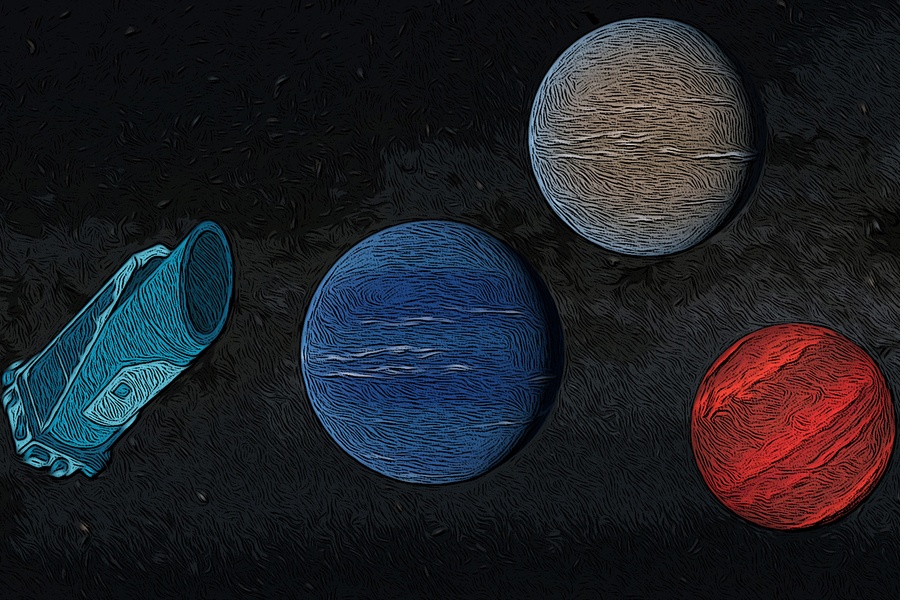
NASA’s Kepler spacecraft ended its observations in October 2018 after nine and a half years, a solid six years beyond its planned duration. It discovered 2,711 confirmed exoplanets and another 2,056 exoplanet candidates as of August 2022.
Now, astronomers at MIT and the University of Wisconsin uncovered three more exoplanets in the data from Kepler’s final days of observations. They needed the help of dedicated amateurs to do it.
Kepler was still operating when NASA launched Kepler’s successor, the Transiting Exoplanet Survey Satellite (TESS,) in August 2018. When Kepler’s mission ended later that year, it passed the planet-hunting baton over to TESS. TESS is doing great, but Kepler still accounts for over half of the confirmed exoplanets we know of. That’s impressive, and the number ticks a little higher with the newest three.
Kepler worked hard right up until its end. As it ran out of fuel for its reaction control system in October 2018, it kept watching stars in its targeted part of the sky for the tell-tale dips in light that signal a passing planet. It spotted three dips around three separate stars in the same section of the sky. Two of those dips are now confirmed exoplanets, and the other is a candidate awaiting confirmation.
A new paper in Monthly Notices of the Royal Astronomical Society presents the findings. It’s titled “Kepler’s last planet discoveries: two new planets and one single-transit candidate from K2 campaign 19.” The lead author is Elyse Incha, from the University of Wisconsin at Madison. Other authors come from NASA, CfA Harvard and Smithsonian, and the University of North Carolina. Amateur astronomers Tom Jacobs and Daryll LaCourse are also part of the team.
“As some of the last discoveries ever made by the Kepler space telescope, these planet candidates hold significance both sociologically and scientifically.”
From ‘Kepler’s last planet discoveries: two new planets and one single-transit candidate from K2 campaign 19.’
When Kepler began to run out of fuel, it worked hard to fulfill its mission. It relied on its reaction control system, which included reaction wheels and hydrazine thrusters. As it ran out of hydrazine, it struggled to keep itself pointed at its targets. For nearly a month, results were dicey.
For about 8.5 days, it was pointed off-center. It eventually got itself oriented properly for about 7.5 days and performed its observations normally during that period. Then things took a turn for the worse. Kepler could only point itself erratically as the thrusters could only burn intermittently, struggling to keep the spacecraft functioning. This erratic period lasted about 11 days.
The data from the final 11 days was incomplete. Only parts of light curves from that period were usable. After 11 days of that, the Kepler team faced the end. There simply wasn’t enough thruster fuel to continue.
That marked the end of Kepler’s 19th observing campaign and the end of its mission. Kepler recorded 27 days of data during campaign 19, but much of it was compromised. Only 7.5 days of the data were suitable for reduction with existing pipelines. (Missions like Kepler gather a massive amount of raw data that has to be processed with data pipelines to become usable.)
The research team behind the new paper says they focused on the 7+ days of precise photometry from the middle of campaign 19 and processed them into light curves. “This process removed systematic errors from Kepler’s instability, leaving behind clean light curves,” they explain in their paper.
“We were curious to see whether we could get anything useful out of this short dataset,” co-author Andrew Vanderburg from MIT’s Kavli Institute said in a press release. “We tried to see what last information we could squeeze out of it.”
This created an enormous number of light curves to examine, all of them by human eyes. “The light curves of all 33,000 stars were searched by members of our team by eye,” they explain, by using a standard process outlined by other exoplanet researchers. After some detailed processing necessitated by Kepler’s erratic pointing, the researchers identified three light curves that indicated planets orbiting stars.
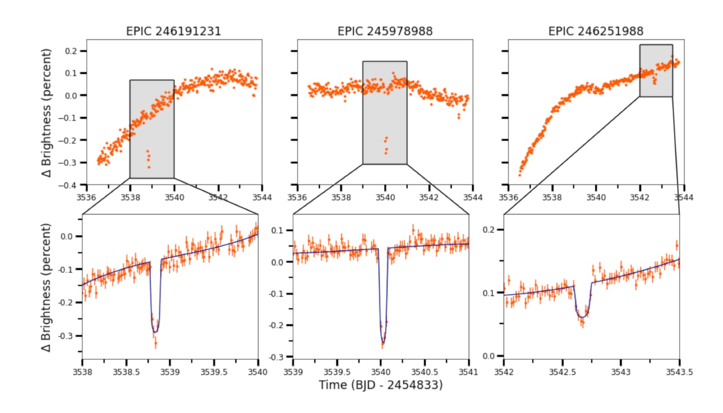
This figure from the paper shows the light curves from the three stars hosting the exoplanets. They all have the prefix EPIC, which stands for Ecliptic Plane Input Catalog, a publicly searchable database of stars and planets associated with Kepler’s K2 mission, the second part of its overall mission. Image Credit: Incha et al. 2023.
“We have found what are probably the last planets ever discovered by Kepler, in data taken while the spacecraft was literally running on fumes,” says Andrew Vanderburg, assistant professor of physics at MIT’s Kavli Institute for Astrophysics and Space Research. “The planets themselves are not particularly unusual, but their atypical discovery and historical importance makes <sic> them interesting.”
K2-416 b and K2-417 b are the two confirmed exoplanets. K2-416 b is about 2.6 times larger than Earth and orbits its star, an M-dwarf, every 13 days. K2-417 b is a little larger, about 3 times larger than Earth. It orbits its star, a G-type star, every 6.5 days.
The third planet, EPIC 246251988 b, is still a candidate and retains the EPIC prefix. It’s the largest of the three, about 4 times larger than Earth. It orbits its star, also an M-dwarf, every 10 days and is much further away from us than the other two.
The discovery involved a lot of human eye work. The Visual Survey Group (VSG) is a team of amateur and professional astronomers that hunt for exoplanets in telescope data. As of 2022, the VSG has visually surveyed over 10 million light curves and authored 69 peer-reviewed papers. The group has proven its value by identifying objects in light curve data that automated search programs either discarded or overlooked. VSG’s primary focus is exoplanets, but they’ve also found cataclysmic variables, eclipsing binaries, and ‘black swans,’ which are unpredictable events beyond normal expectations.
“They (VSG) can distinguish transits from other wacky things like a glitch in the instrument,” Vanderburg says. “That’s helpful, especially when your data quality begins to suffer like it did in K2’s last bit of data.”
Initially, the team examined the 7.5 days of strong data. In it, they found single transits for three separate stars. Then they examined the final 11 days of lower-quality observations. They needed to find additional transits to confirm them as planets. They found additional transits for two of the planets, K2-416 b and K2-417 b. The team found additional data from NASA’s TESS for one of the planets, K2-417 b, which also helped confirm it.
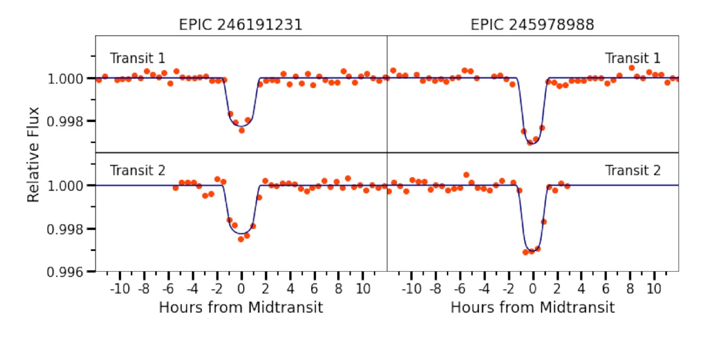
This figure from the research shows both transits detected for each newly confirmed exoplanet. Image Credit: Incha et al. 2023.
“Those two are pretty much, without a doubt, planets,” Incha said. “We also followed up with ground-based observations to rule out all kinds of false positive scenarios for them, including background star interference, and close-in stellar binaries.”
Eclipsing binaries (EBs) can appear as exoplanet transits and must be eliminated as a possibility before a candidate planet is confirmed. As they orbit one another, EBs can block each other’s light, creating dips from our perspective. The team examined historical observations of both stars from decades ago to eliminate the possibility that any of their light curves were caused by EBs.
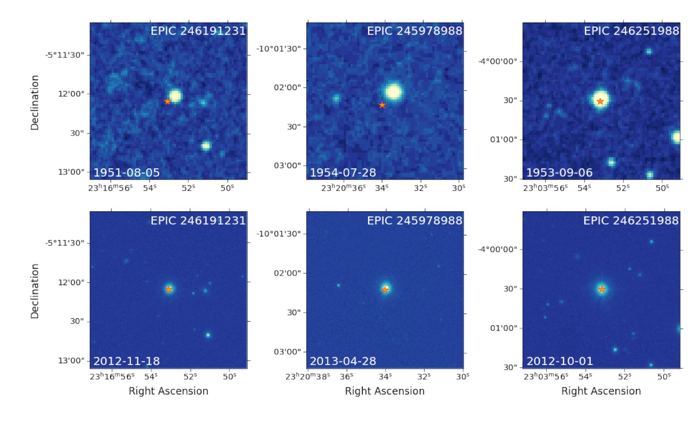
This figure is a comparison of images of each star. The top row is images of the stars from a sky survey done in the 1950s, and the bottom row is images taken with Pan-STARRS. Orange stars mark the locations of all three stars. The first two comparisons eliminate the possibility of EBs, while for the third star, the proper motion is too small to eliminate the possibility. It remains a candidate. Image Credit: Incha et al. 2023.
Despite the team’s work, they were not able to conclude that the third transiting event is, in fact, an exoplanet. It could very well be a high-mass brown dwarf. “Our constraints for EPIC 246251988 are weakest because it lacks a precisely measured orbital period, and we struggle to confidently rule out even high-mass brown dwarfs in the long-period tail of the probability distribution,” the authors explain in their paper. “Nevertheless, the preponderance of the evidence points to a planetary mass for any companion orbiting EPIC 246251988.”
The three planets are not unusual. They’re fairly typical of the population of sub-Neptune size objects detected by the transit method. Of the over 5400 confirmed exoplanets, over 1800 of them are Neptune-like. That’s about 33%. These planets have radii that indicate the presence of a volatile envelope of some size.
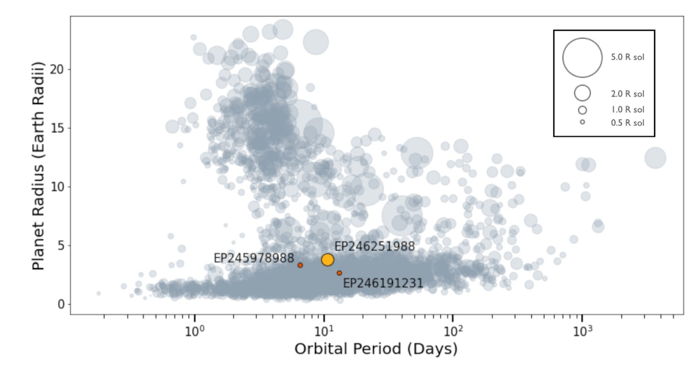
This figure from the research shows how the three new planets compare to the population of known transiting exoplanets. The x-axis shows the orbital period, and the y-axis shows the radius. All three are fairly typical. Image Credit: Incha et al. 2023.
These are likely the final three planets that Kepler found. The team rigorously examined the light curves from 33,000 stars captured during the spacecraft’s final days to find them, and because human eyes were involved, it’s unlikely there are any more transits in all those curves. But they may not be the last exoplanets found in Kepler’s vast collection of data.
“These are the last chronologically observed planets by Kepler, but every bit of the telescope’s data is incredibly useful,” Incha says. “We want to make sure none of that data goes to waste, because there are still a lot of discoveries to be made.”
“As some of the last discoveries ever made by the Kepler space telescope, these planet candidates hold significance both sociologically and scientifically,” the researchers write in the conclusion to their paper. “We hope our work will help ensure that all Kepler data are utilized to its full potential so that no planets are left behind.”





